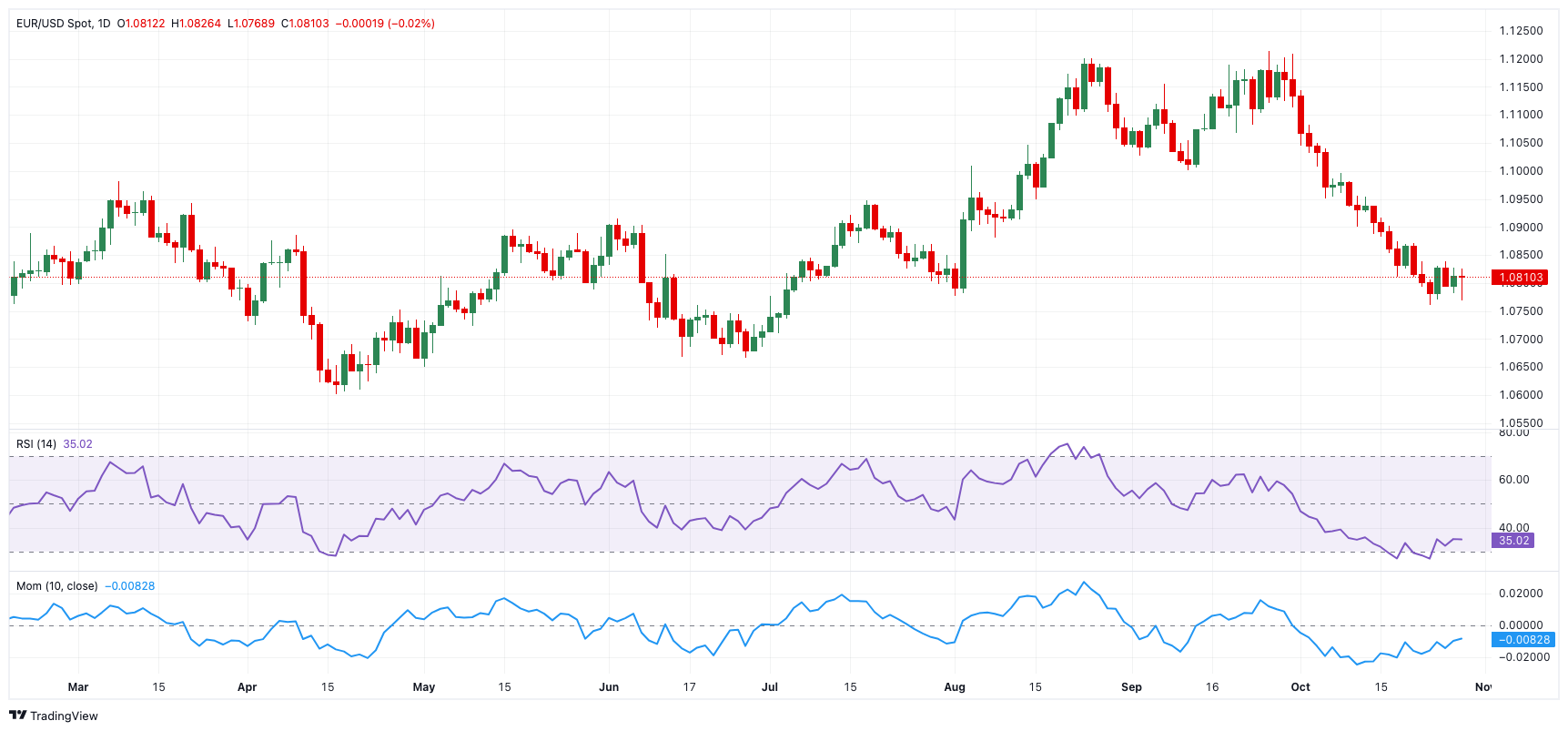- EUR/USD alternated gains with losses around the 1.0800 region.
- The US Dollar clung to daily gains following fresh tops.
- US Q3 GDP data, the ADP report, and German CPI come to the fore.
On Tuesday, EUR/USD struggled to extend Monday’s decent rebound, navigating a volatile range around the 1.0800 region after bottoming out near 1.0770 early in the day.
The pair, however, remained below the key 200-day Simple Moving Average (SMA) at 1.0868, suggesting the potential for further downside in the near term.
The US Dollar’s (USD) rally showed signs of slowing its momentum despite the Dollar Index (DXY) clinching new highs past 104.60, while US yields also failed to sustain the initial bullish attempt vs. an acceptable bounce in German 10-year bund yields.
Looking ahead, expectations are building for a 25-basis-point rate cut by the Fed next month. However, some officials, including FOMC Governor Michelle Bowman and Atlanta Fed President Raphael Bostic, have expressed doubts. Bostic even suggested that the Fed might postpone a rate cut in November.
Currently, the CME Group’s FedWatch Tool almost fully prices in a quarter-point cut at the November 7 meeting.
Across the Atlantic, the European Central Bank (ECB) delivered a 25-basis-point rate cut on October 17, reducing the Deposit Facility Rate to 3.25%, in line with expectations. ECB officials have adopted a cautious stance on further rate changes, emphasizing the importance of incoming economic data. ECB President Christine Lagarde highlighted the need for prudence in future policy decisions amid the evolving economic environment.
Within the ECB, there are varying opinions on future rate cuts. Robert Holzmann supports a potential quarter-point reduction in December, while Bostjan Vasle advocates for “measured” cuts, cautioning against premature easing. Joachim Nagel warned against concluding the fight against inflation too early, and Martins Kazaks pointed out that although eurozone inflation, as measured by the Harmonised Index of Consumer Prices (HICP), declined to 1.7% year-on-year in September—below the ECB’s target—stagnant GDP growth and continued weakness in German and eurozone business activity, particularly in manufacturing, suggest that gradual rate cuts remain necessary amid high uncertainty.
As both the Fed and ECB consider their next steps, the trajectory of EUR/USD is likely to depend on broader economic trends. With the US economy currently outperforming the eurozone, the USD may maintain its strength in the near to medium term. Additional support for the USD is expected in the event of a Trump victory in the upcoming election.
Furthermore, the latest CFTC Positioning Report for the week ending October 22 indicated that speculators shifted to a net short position on the euro for the first time since late April, while overall open interest continued to decline. During this period, EUR/USD remained under pressure, breaking below the 1.0900 support level and continuing a downward trend that began at the start of the month.
Looking ahead, the release of the advanced US Q3 GDP Growth Rate, the ADP report, and Germany’s flash inflation figures are expected to dictate the sentiment in the very near term.
EUR/USD daily chart
EUR/USD short-term technical outlook
Further losses could drive EUR/USD to its October low of 1.0760 (October 23), clearing the way for a test of the round level at 1.0700 before the June low of 1.0666 (June 26).
On the upside, the 200-day SMA at 1.0868 is ahead, followed by the preliminary 100-day and 55-day SMAs at 1.0933 and 1.1023, respectively. The 2024 peak of 1.1214 (September 25) comes next, followed by the 2023 high of 1.1275 (July 18).
Meanwhile, the pair’s outlook should remain unfavourable as long as EUR/USD trades below the key 200-day SMA.
The four-hour chart shows the continuation of a range bound mood. Nonetheless, the initial support is at 1.0760, followed by 1.0666. On the upside, the first barrier is at 1.0839, followed by 1.0954 and 1.0996. The relative strength index (RSI) rose to nearly 50.




